
Matteo Ricci (left) and Xu Guangqi (right) in the Chinese edition of Euclid's Elements published in 1607.
Contacts between Asia and the west already dated back hundreds of years, especially between the Papacy and the Mongol Empire in the 13th century. There were also numerous traders that traveled between the continents, the most famous of which is Marco Polo. Christianity was not new to the Mongols, as many had been practicing Christianity of the Church of the East since the 7th century (see Christianity among the Mongols). However, the overthrow of the Mongol Yuan Dynasty by the Ming in 1368 resulted in a strong assimilatory pressure on China's Muslim, Jewish, and Christian communities, and outside influences were forced out of China. By the 16th century, there is no reliable information about any practicing Christians remaining in China.
The first Portuguese explorer credited with reaching China was Jorge Álvares in 1513. Unlike the early European travelers of the 14th and 15th century, who reached China overland by traveling thousands of miles through Mongol- or Muslim-controlled territory, during the Age of Discovery of the 15th to 17th centuries, Europeans were arriving to China's southeastern coast in their own boats, from Portuguese-controlled Malacca or the Spanish Philippines.
Fairly soon after the establishment of the direct European maritime contact with China (1513), and the creation of the Society of Jesus (1540), at least some Chinese become involved with the Jesuit effort. As early as 1546, two Chinese boys became enrolled into the Jesuits' St. Paul's College in Goa, the capital of Portuguese India. It is one of these two Christian Chinese, known as Antonio, who accompanied St. Francis Xavier, a co-founder of the Society of Jesus, when he decided to start missionary work in China. However, Xavier was not able to find a way to enter the Chinese mainland, and died in 1552 on Shangchuan island off the coast of Guangdong,[5] the only place in China where Europeans were allowed to stay at the time, but only for seasonal trade.
A few years after Xavier's death, the Portuguese were allowed to establish Macau, a semi-permanent settlement on the mainland which was about 100 km closer to the Pearl River Delta than Shangchuan Island. A number of Jesuits visited the place (as well as the main Chinese port in the region, Guangzhou) on occasions, and in 1563 the Order permanently established its settlement in the small Portuguese colony. However, the early Macau Jesuits did not learn Chinese, and their missionary work could reach only the very small number of Chinese people in Macau who spoke Portuguese.[6]
It was the new regional manager ("Visitor") of the order, Alessandro Valignano, who, on his visit to Macau in 1578-1579 realized that Jesuits weren't going to get far in China without a sound grounding in the language and culture of the country. He founded St. Paul Jesuit College (Macau) and requested the Order's superiors in Goa to send a suitably talented person to Macau to start the study of Chinese. Accordingly, in 1579 the Italian Michele Ruggieri (1543–1607) was sent to Macau, and in 1582 he was joined at his task by another Italian, Matteo Ricci (1552–1610).[6]
Ricci's policy of accommodation
Ricci, Ruggieri, and their followers, had a desire of creating a Sino-Christian civilization that would match the Roman-Christian civilization of the West. Both Ricci and Ruggieri were determined to adapt to the religious qualities of the Chinese: Ruggieri to the common people, in whom Buddhist and Taoist elements predominated, and Ricci to the educated classes, where Confucianism prevailed. Ricci, who arrived at the age of 30 and spent the rest of his life in China, wrote to the Jesuit houses in Europe and called for priests - men who would not only be "good", but also "men of talent, since we are dealing here with a people both intelligent and learned".[7]
A few responded, and Ricci began to train them so that they might approach the Chinese authorities, offering the court scholarly and scientific assistance. Ricci's followers had the deliberate intention of completely de-westernizing themselves, to make a Confucian adaptation of their style of life, patterns of thought, preaching and worship. Both Ricci and Ruggieri felt that it would be possible to "prove that the Christian doctrines were already laid down in the classical works of the Chinese people, albeit in disguise". Indeed, they and their followers were convinced that "the day would come when with one accord all missionaries in China would look in the ancient texts for traces of primal revelation".[8]
http://upload.wikimedia.org/wikipedi...602_Larger.jpg
Map of the Far East in 1602, by Jesuit missionary Matteo Ricci (1552–1610)
Tension eventually developed between Ricci and his followers and those of Ruggieri. Ricci's focus was on adapting to Confucianism and strongly rejecting Taoism, while Ruggieri's thesis was that there was a closer affinity between the Tao of Chinese thought and the incarnate Logos of the New Testament.
In 1584 Ruggieri published the first Jesuit Latin book in China, which was later translated into Chinese by Ricci with a name of Tien Zhu Shi-lu (天主實錄 The True Account of God).[9] In it he discussed the existence and attributes of God, as well as his providence. He explained how a man might know God through the natural law, the Mosaic law, and the Christian law. He wrote of the incarnation of Christ the Word and discussed the sacraments.
In his diary, Ricci wrote: "From morning to night, I am kept busy discussing the doctrines of our faith. Many desire to forsake their idols and become Christians".[10] His missionary directives were explicit:
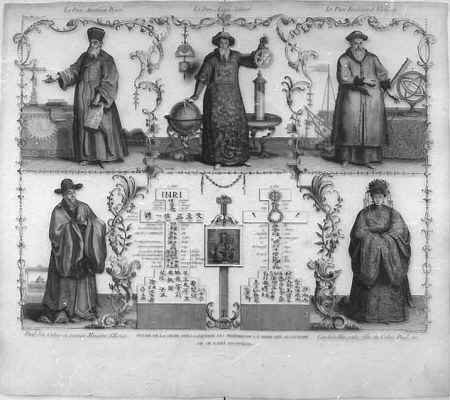
Represented (top): Matthieu Ricci, Adam Schaal, Ferdinand Verbiest
Bottom: Paul Siu (Xu Guangqi), colao or Prime Minister of State; Candide Hiu, grand-daughter of Colao Paul Siu.
[IMG]http://upload.wikimedia.org/wikipedia/commons/thumb/2/2e/Les_Astronomes_Jesuit_astronomers_with_Chinese_sch olars_Beauvais_18th_century.jpg/659px-
Jesuit astronomers with Chinese scholars, Les Astronomes, Beauvais tapestry, 18th century.
"The work of evangelization, of making Christians, should be carried on both in Peking and in the provinces… following the methods of pacific penetration and cultural adaptation. Europeanism is to be shunned. Contact with Europeans, specifically with the Portuguese in Macau, should be reduced to a minimum. Strive to make good Christians rather than multitudes of indifferent Christians… Eventually when we have a goodly number of Christians, then perhaps it would not be impossible to present some memorial to the Emperor asking that the right of Christians to practice their religion be accorded, inasmuch as is not contrary to the laws of China. Our Lord will make known and discover to us little by little the appropriate means for bringing about in this matter His holy will.[11]
When Ricci died in 1610 in Beijing, more than two thousand Chinese from all levels of society had confessed their faith in Jesus Christ. Just as Ricci spent his life in China, others of his followers did the same. This level of commitment was necessitated by logistical reasons: Travel from Europe to China took many months, and sometimes years; and learning the country's language and culture was even more time-consuming. When a Jesuit from China did travel back to Europe, he typically did it as a representative ("procurator") of the China Mission, entrusted with the task of recruiting more Jesuit priests to come to China, ensuring continued support for the Mission from the Church's central authorities, and creating favorable publicity for the Mission and its policies by publishing both scholarly and popular literature about China and Jesuits.[12] One time Chongzhen Emperor was nearly converted to Christianity and broke his idols.[13]
Dynastic change
The fall of the Ming Dynasty (1644) and the conquest of China by the Manchu Qing regime brought some difficult years for the Jesuits in China. While some Jesuit fathers managed to impress Manchu commanders with a display of western science of ecclesiastical finery and to be politely invited to join the new order (as did Johann Adam Schall von Bell in Beijing in 1644, or Martino Martini in Wenzhou ca. 1645-46),[14] others endured imprisonment and privations, as did Lodovico Buglio and Gabriel de Magalhaes in Sichuan in 1647-48[15][16] or Alvaro Semedo in Canton in 1649. Later, Johann Grueber was in Beijing between 1656 and 1661.
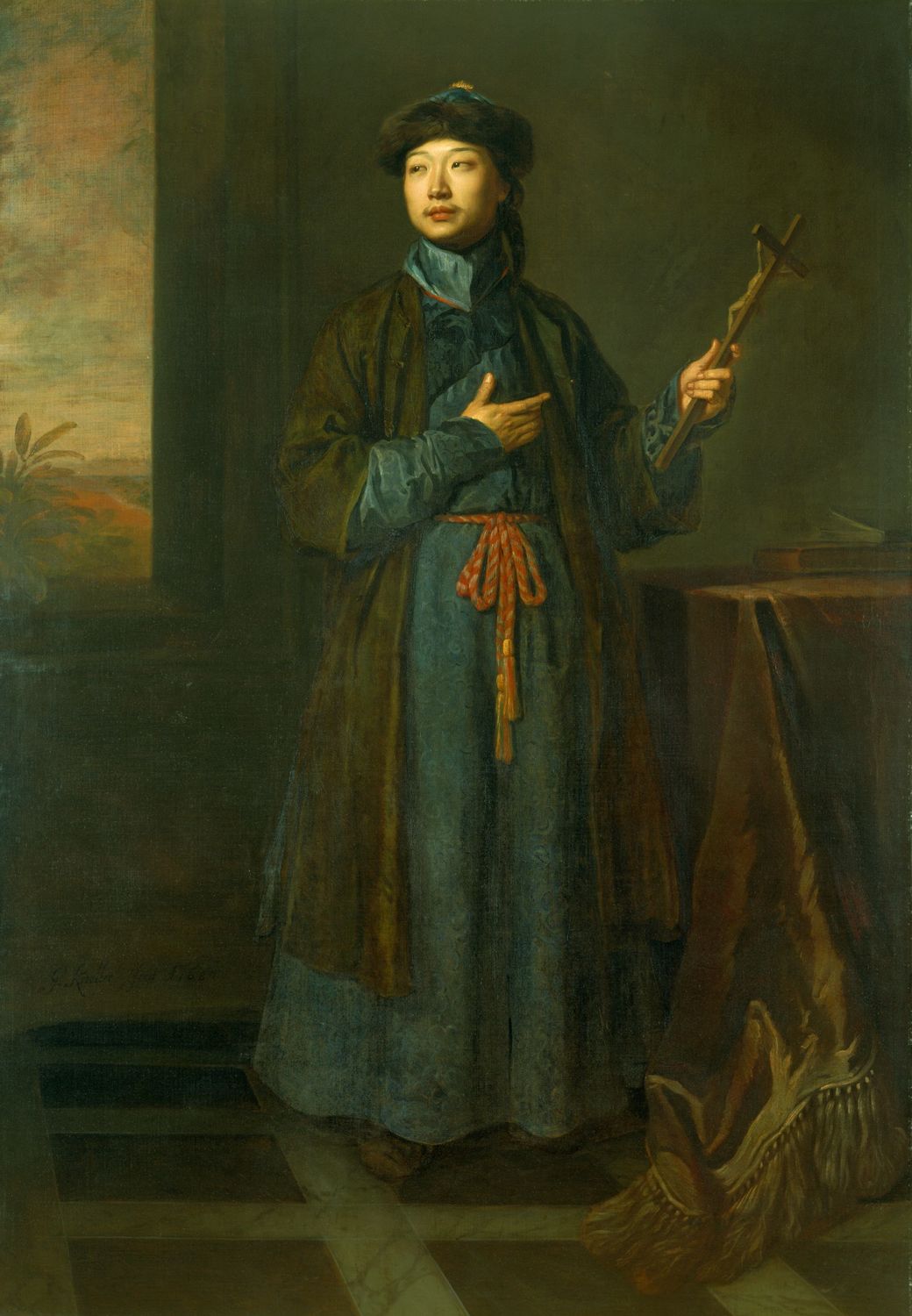
The Chinese Jesuit Michael Alphonsius Shen Fu-Tsung visited France and Britain in 1684-1685. "The Chinese Convert" by Sir Godfrey Kneller.
During the several years of war between the newly established Qing and the Ming loyalist in southern China, it was not uncommon for some Jesuits to find themselves on different sides of the front lines: while Adam Schall was an important counselor of the Qing Shunzhi Emperor in Beijing, Michał Boym travelled from the jungles of south-western China to Rome, carrying the plea of help from the court of the last Southern Ming emperor Zhu Youlang (the Yongli Emperor), and returned with the Pope's response that promised prayer, after some military assistance from Macau.[17][18][19] The emperor was against monogamy but many people in his court had been baptized.
French Jesuits
In 1685, the French king Louis XIV sent a mission of five Jesuit "mathematicians" to China in an attempt to break the Portuguese predominance: Jean de Fontaney (1643–1710), Joachim Bouvet(1656–1730), Jean-François Gerbillon (1654–1707), Louis Le Comte (1655–1728) and Claude de Visdelou (1656–1737).[20]
Travel of Chinese Christians to Europe
See also: Rabban bar Sauma
Prior to the Jesuits, there had already been Chinese pilgrims who had made the journey westward, with two notable examples being Rabban bar Sauma and his younger companion who became Patriarch Mar Yaballaha III, in the 13th century.
While not too many 17th-century Jesuits ever went back from China to Europe, it was not uncommon for them to be accompanied by young Chinese Christians. One of the earliest Chinese travelers to Europe was Andreas Zheng (郑安德勒; Wade-Giles: Cheng An-te-lo), who was sent to Rome by the Yongli court along with Michał Boym in the late 1650. Zheng and Boym stayed in Venice and Rome in 1652-55. Zheng worked with Boym on the transcription and translation of the Nestorian Monument, and returned to Asia with Boym, whom he buried when the Jesuit died near the Vietnam-China border.[21] A few years later, another Chinese traveller who was called Matthaeus Sina in Latin (not positively identified, but possibly the person who traveled from China to Europe overland with Johann Grueber) also worked on the same Nestorian inscription. The result of their work was published by Athanasius Kircher in 1667 in the China Illustrata, and was the first significant Chinese text ever published in Europe.[22]
Better known is the European trip of Shen Fo-tsung in 1684–1685, who was presented to king Louis XIV on September 15, 1684, and also met with king James II,[23] becoming the first recorded instance of a Chinese man visiting Britain.[24] The king was so delighted by this visit that he had his portrait made, and had it hung in his bedroom.[24] Later, Arcadio Huang, another Chinese Jesuit, would also visit France, and was an early pioneer in the teaching of the Chinese language in France in 1715.
Scientific exchange
See also: History of science and technology in China
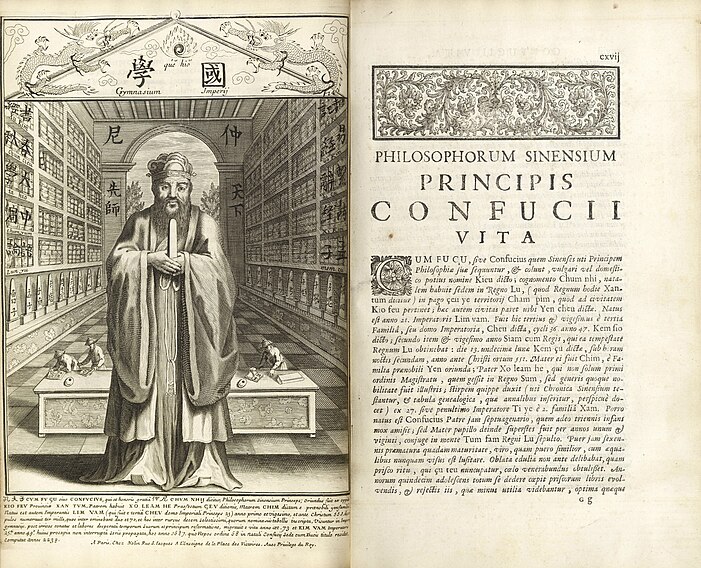
Confucius Sinarum Philosophus ("Life and works of Confucius"), by Father Philippe Couplet and Father Prospero Intorcetta, 1687.
Telling China about Europe
The Jesuits introduced Western science and math, then undergoing its own revolution, to China. "Jesuits were accepted in late Ming court circles as foreign literati, regarded as impressive especially for their knowledge of astronomy, calendar-making, mathematics, hydraulics, and geography."[25] In 1627, the Jesuit Johann Schreck produced the first book to present Western mechanical knowledge to a Chinese audience, Diagrams and explanations of the wonderful machines of the Far West.[26] This influence worked in both directions:
[The Jesuits] made efforts to translate western mathematical and astronomical works into Chinese and aroused the interest of Chinese scholars in these sciences. They made very extensive astronomical observation and carried out the first modern cartographic work in China. They also learned to appreciate the scientific achievements of this ancient culture and made them known in Europe. Through their correspondence European scientists first learned about the Chinese science and culture.—[27]
Sabatino de Ursis (1575–1620) worked with Matteo Ricci on the Chinese translation of Euclid's Elements, published books in Chinese on Western hydraulics, and by predicting an eclipse which Chinese astronomers had not anticipated, opened the door to the reworking of the Chinese calendar using Western calculation techniques.
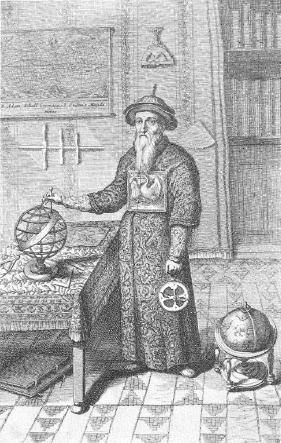
Portrait of Johann Adam Schall
Johann Adam Schall (1591–1666), a German Jesuit missionary to China organized successful missionary work, and became the trusted counsellor of the Shunzhi emperor of the Qing dynasty. He was created a mandarin, and held an important post in connection with the mathematical school, contributing to astronomical studies and the development of the Chinese calendar. Thanks to Schall, the motions of both the sun and moon began to be calculated with sinusoids in the 1645 Shíxiàn calendar (時憲書, Book of the Conformity of Time). His position enabled him to procure from the emperor permission for the Jesuits to build churches and to preach throughout the country. The Shunzhi emperor, however, died in 1661, and Schall's circumstances at once changed. He was imprisoned and condemned to slow slicing death. After an earthquake and the dowager's objection the sentence was not carried out, but he died after his release owing to the privations he had endured. A collection of his manuscripts remains, and was deposited in the Vatican Library. After he and Ferdinand Verbiest won the tests against Chinese and Islamic calendar scholars, the court adapted the western calendar only.[28][29]
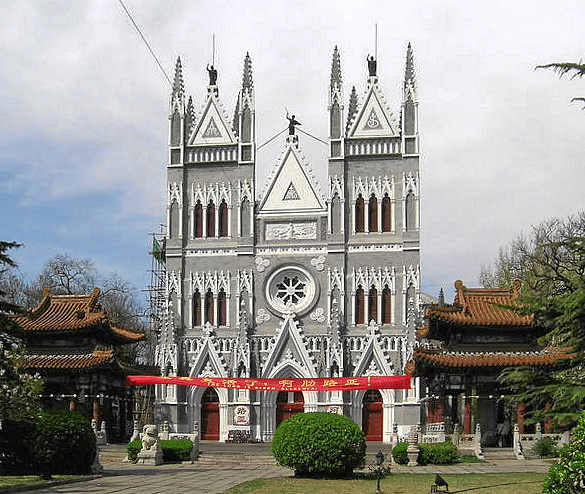
The Beitang Church was established in Beijing by the Jesuits in 1703.
The Jesuits also endeavoured to build churches and demonstrate Western architectural styles. In 1605, they established the Nantang (Southern) Church, and in 1655 the Dongtang (Eastern) Church. In 1703 they established the Beitang (Northern) Church near Zhongnanhai (opposite the former Beijing Library), on a land bestowed by Emperor Kangxi of the Qing Dynasty to the Jesuit in 1694, following his recovery from illness thanks to medical expertise of Fathers Jean-François Gerbillon and Joachim Bouvet.[30]
Telling Europe about China
The Jesuits were also very active in transmitting Chinese knowledge to Europe, such as translating Confucius's works into European languages. Ricci in his De Christiana expeditione apud Sinas had already started to report on the thoughts of Confucius; he (and, earlier, Michele Ruggieri) made attempts at translating the Four Books, the standard introduction into the Confucian canon. The work of several generations of Jesuits on the Confucian classics culminated with Fathers Philippe Couplet, Prospero Intorcetta et al. publishing Confucius Sinarum Philosophus ("Confucius, the Philosopher of the Chinese") in Paris in 1687. The book contained an annotated Latin translation of three of the Four Books, and a biography of Confucius.[31] It is thought that such works had considerable importance on European thinkers of the period, particularly those who were interested by the integration of the system of morality of Confucius into Christianity.[32][33]
Since the mid-17th century, detailed Jesuits' accounts of the Eight trigrams and the Yin/Yang principles[34] appeared in Europe; soon, they attracted significant attention of European philosophers, such as Leibniz.
http://upload.wikimedia.org/wikipedi...-1734-2568.jpg
The 1734 map compiled by d'Anville based on the Jesuits' geographic research during the early 1700s Chinese sciences and technologies were also reported to the West by Jesuits. The French Jesuit Joseph-Marie Amiot wrote a Manchu dictionary Dictionnaire tatare-mantchou-français (Paris, 1789), a work of great value, the language having been previously quite unknown in Europe. He also wrote a 15 volume Treaty regarding the history, sciences and art of the Chinese, published in Paris in 1776-1791 (Mémoires concernant l'histoire, les sciences et les arts des Chinois, 15 volumes, Paris, 1776–1791). His Vie de Confucius, the twelfth volume of that collection, was more complete and accurate than any predecessors.
In the early years of the 18th century, Jesuit cartographers travelled all over the Chinese Empire, performing astronomical observations to determine latitude and longitude (relative to Beijing) of various locations and drawing maps. Their work was summarized in a four-volume Description géographique, historique, chronologique, politique et physique de l'empire de la Chine et de la Tartarie chinoise published by Jean-Baptiste Du Halde in Paris in 1735, and a map compiled by Jean Baptiste Bourguignon d'Anville (published 1734).[35]
Chinese Rites Controversy
Main article: Chinese Rites controversy
In the early 18th century, a dispute within the Catholic Church arose over whether Chinese folk religion rituals and offerings to the emperor constituted paganism or idolatry. This tension led to what became known as the "Rites Controversy," a bitter struggle that broke out after Ricci's death and lasted for over a hundred years.
At first the focal point of dissension was the Jesuit Ricci's contention that the ceremonial rites of Confucianism and ancestor veneration were primarily social and political in nature and could be practiced by converts. The Dominicans, however, charged that the practices were idolatrous, meaning that all acts of respect to the sage and one's ancestors were nothing less than the worship of demons. A Dominican carried the case to Rome, where it dragged on and on, largely because no one in the Vatican knew Chinese culture sufficiently to provide the pope with a ruling. Naturally, the Jesuits appealed to the Chinese emperor, who endorsed Ricci's position.
Understandably, the emperor was confused, as to why missionaries were attacking missionaries in his capital, and asking him to choose one side over the other, when he might very well have simply ordered the expulsion of all of them.

The French Jesuit Joseph-Marie Amiot (1718-1793) was official translator of Western languages for Emperor Qianlong.
The timely discovery of the Nestorian monument in 1623 enabled the Jesuits to strengthen their position with the court by answering an objection the Chinese often expressed - that Christianity was a new religion. The Jesuits could now point to concrete evidence that a thousand years earlier the Christian gospel had been proclaimed in China; it was not a new but an old faith. The emperor then decided to expel all missionaries who failed to support Ricci's position.
The Spanish Franciscans, however, did not retreat without further struggle. Eventually they persuaded Pope Clement XI that the Jesuits were making dangerous accommodations to Chinese sensibilities. In 1704 they prescribed against the ancient use of the words Shang Di (Supreme God/similar to the Creator Christian God 'Yahweh' ) and Tien (Heaven). Again, the Jesuits appealed this decision.
The controversy raged on. In 1742 Pope Benedict XIV officially opposed the Jesuits, forbade all worship of ancestors, and terminated further discussion of the issue. This decree was repealed in 1938. But the methodology of Matteo Ricci remained suspect until 1958, when Pope John XXIII, by decree in his encyclical Princeps Pastorum, proposed that Ricci become "the model of missionaries."[citation needed]
In the intervening years the Ming Dynasty collapsed (1644), to be replaced by the "non-scholarly" and foreign Manchus. At first, the Jesuits were employed and welcome in the court of K'ang-hsi. However, when Pope Clement XI attempted to send Maillard de Tournon as an emissary to control the Jesuit Missionaries and restrict Christian tolerance and practice of Chinese Rites, the request was denied by K'ang-hsi. Further, Jesuit missionaries had to sign a document stating that they agreed to Confucian and ancestral rituals, and those who did not sign were deported. Maillard himself was imprisoned. In spite of this, the Jesuits continued to preach and work in China - but over time, the influence of the Catholic missionary orders began to wane. Pope Clement XIV dissolved the Society of Jesus in 1773. The withdrawal from China of this dynamic segment of the missionary force exposed the church to successive waves of persecution. Although many Chinese Christians were put to death and the congregation scattered, the church continued to manifest a "tough inward vitality" and kept growing.
Among the last Jesuits to work at the Chinese court were Louis Antoine de Poirot (1735–1813) and Guiseppe Panzi (1734-before 1812) who worked for Emperor Qianlong as painters and translators.[36][37] From the 19th century, the role of the Jesuits in China was largely taken over by the Paris Foreign Missions Society.
No comments:
Post a Comment
Comments always welcome!